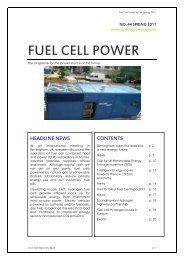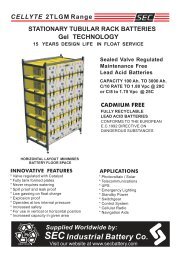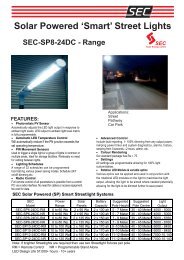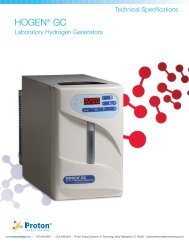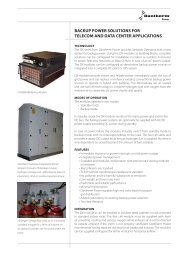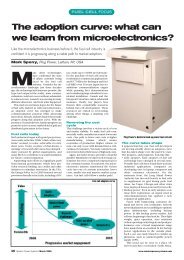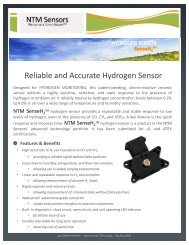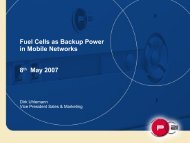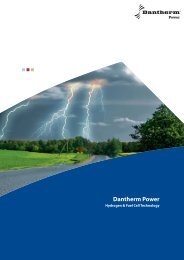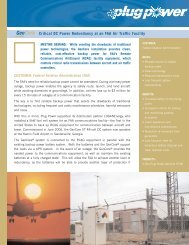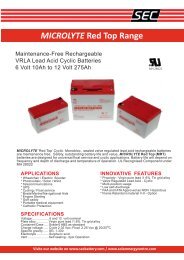A renaissance for alkaline fuel cells - Fuel Cell Markets
A renaissance for alkaline fuel cells - Fuel Cell Markets
A renaissance for alkaline fuel cells - Fuel Cell Markets
Create successful ePaper yourself
Turn your PDF publications into a flip-book with our unique Google optimized e-Paper software.
INNOVATION<br />
A brief history of AFC applications<br />
An ELOFLUX <strong>fuel</strong>-cell cell stack<br />
from German developer<br />
Gaskatel. The ELOFLUX<br />
principle is based on flexible<br />
electrodes and a liquid<br />
electrolyte. The electrodes are<br />
extremely porous, with both<br />
hydrophobic and hydrophilic<br />
pores allowing the transport of<br />
gases and electrolyte, and with<br />
a thin separator between<br />
(approximately 0.3 mm).<br />
It’s within the US space programme that AFCs have enjoyed their<br />
greatest successes. In the 1960s and early 1970s, AFCs were used on<br />
nine Apollo Moon flights and three Sky Labs – a total of 54 missions.<br />
They have also been employed on the Space Shuttle since its first<br />
flight in 1975 and are still in use today.<br />
In terms of more down-to-earth applications, a number of isolated<br />
and diverse projects have relied on the AFC to deliver power from<br />
hydrogen. In the mid-1960s, <strong>for</strong> example, the US tractor maker Allis<br />
Chalmers pioneered the first “civilian” usage: a 15 kW power module<br />
<strong>for</strong> one of its vehicles. Also in the US, Union Carbide developed a<br />
number of initial uses, including a General Motors “Electrovan”<br />
powered by a 125 kW AFC in 1967. Three years later, one of Carbide’s<br />
inventors, Karl Kordesch, completed an Austin A-40 hybrid vehicle<br />
that relied on a 96 V, air-breathing AFC in combination with a leadacid<br />
battery. Kordesch operated the Austin A-40 <strong>for</strong> three years in city<br />
traffic, the <strong>fuel</strong> cell being shut-down and restarted as required by<br />
normal operation.<br />
In terms of European industrial activity, Elenco of Belgium<br />
completed a number of AFC systems during the 1970s and 80s,<br />
including a 52 kW system <strong>for</strong> the Belgian Geological Service. In 1994,<br />
the same group completed work on a 200 kW AFC system <strong>for</strong> a<br />
hybrid bus. The following year Elenco was closed, continuing<br />
operations as Zevco and ZeTek (both now defunct as well). These<br />
companies demonstrated an AFC-powered London taxi in 1999 and<br />
contributed to the completion of the Hydra AFC-powered boat,<br />
which was launched in Germany in the summer of 2000. Elsewhere in<br />
Europe, Siemens of Germany dedicated considerable ef<strong>for</strong>t to<br />
developing a <strong>fuel</strong>-cell system <strong>for</strong> submarines, work that was<br />
completed in the early 1990s.<br />
Back in the here and now there are several small companies and<br />
research institutes currently active in AFC technology. They include:<br />
electrodes and a liquid electrolyte. The electrodes are extremely<br />
porous, with both hydrophobic and hydrophilic pores allowing<br />
the transport of gases and electrolyte, and with a thin separator<br />
between (approximately 0.3 mm). In contrast with the<br />
other cell concepts, the electrolyte is transported through the<br />
separator and the electrodes in the direction perpendicular to<br />
the electrode plane.<br />
This AFC demonstrator from<br />
Hydrocell is equipped with an<br />
internal metal-hydride storage<br />
tank. The Finnish company is<br />
also developing portable AFC<br />
units to supply power to<br />
summer residences and lowenergy<br />
buildings. Because of<br />
the internal hydrogen storage,<br />
the device is sometimes called a<br />
“<strong>fuel</strong>-cell battery”, as it is as<br />
easy to use as a lead acid battery.<br />
● Astris Energi (Mississauga, Ontario) develops systems (ranging in<br />
output power from a few hundred watts to several kilowatts) <strong>for</strong> light<br />
utility vehicles, portable applications and stationary systems<br />
targeting backup power and cogeneration. One such generator, the<br />
Model E8, is a 2.4 kW system that uses two 1.2 kW stacks; system<br />
efficiency is >50% and rated life is 2000 h. Astris has established an<br />
R&D laboratory and manufacturing facility in the Czech Republic.<br />
● Deutsches Zentrum für Luft- und Raumfahrt (DLR) is a leading German<br />
aerospace organization. Its Institute of Technical Thermodynamics in<br />
Stuttgart has a long-running R&D programme on low-temperature<br />
<strong>fuel</strong> <strong>cells</strong>, including PEMFCs and AFCs. There are currently more than<br />
a dozen researchers working on various aspects of AFC technology,<br />
including catalysis, gas-diffusion electrodes, electrode production<br />
methodology, development of stacks, modelling and testing.<br />
● Gaskatel (Kassel, Germany) works on <strong>cells</strong>, stacks and systems based<br />
on the ELOFLUX principle. The ELOFLUX <strong>cells</strong> are based on<br />
inexpensive materials – e.g. carbon and nickel – and deliver a power<br />
output up to 0.5 kW/l.<br />
● Ovonic <strong>Fuel</strong> <strong>Cell</strong> Company (Rochester Hills, Michigan, US) is<br />
developing a metal-hydride <strong>fuel</strong> cell that uses <strong>alkaline</strong> electrolyte.<br />
Published benefits include instant start, intrinsic operation down to<br />
–20 ºC and operation without hydrogen <strong>fuel</strong> <strong>for</strong> several minutes.<br />
● Oy Hydrocell (Finland) manufactures portable AFC systems <strong>for</strong> the<br />
supply of power to summer residences and low-energy buildings.<br />
The <strong>fuel</strong> <strong>cells</strong> are normally equipped with internal metal-hydride<br />
hydrogen storage (up to 40 dm 3 of hydrogen). There are two storage<br />
units: HC-MH200 is the size of a small cola can and contains 430 Wh<br />
(12 V DC, 36 Ah) of energy and the HC-MH1200 is the size of a small<br />
fire extinguisher and contains 2600 Wh (12 V DC, 220 Ah) of energy.<br />
● ZAO Independent Power Technologies (Moscow, Russia) is a designer<br />
and manufacturer of AFC-based electrochemical generators.<br />
● Falling-film cell: This <strong>for</strong>mat was developed by Hoechst,<br />
Germany, originally to increase the efficiency of chlor-alkali<br />
electrolysis. The electrolyte flows between the electrodes from<br />
top to bottom. Owing to the unhindered gravitational movement<br />
of the electrolyte in this way, the typical height-dependent<br />
hydrostatic-pressure distribution does not develop – so<br />
hydrostatic pressure in the free-falling column of liquid is the<br />
R EPRINTED WITH PERMISSION. COPYRIGHT I NSTITUTE OF P HYSICS AND IOP PUBLISHING 2006



